fuel pressure TOYOTA SEQUOIA 2019 Owners Manual (in English)
[x] Cancel search | Manufacturer: TOYOTA, Model Year: 2019, Model line: SEQUOIA, Model: TOYOTA SEQUOIA 2019Pages: 560, PDF Size: 10.83 MB
Page 5 of 560
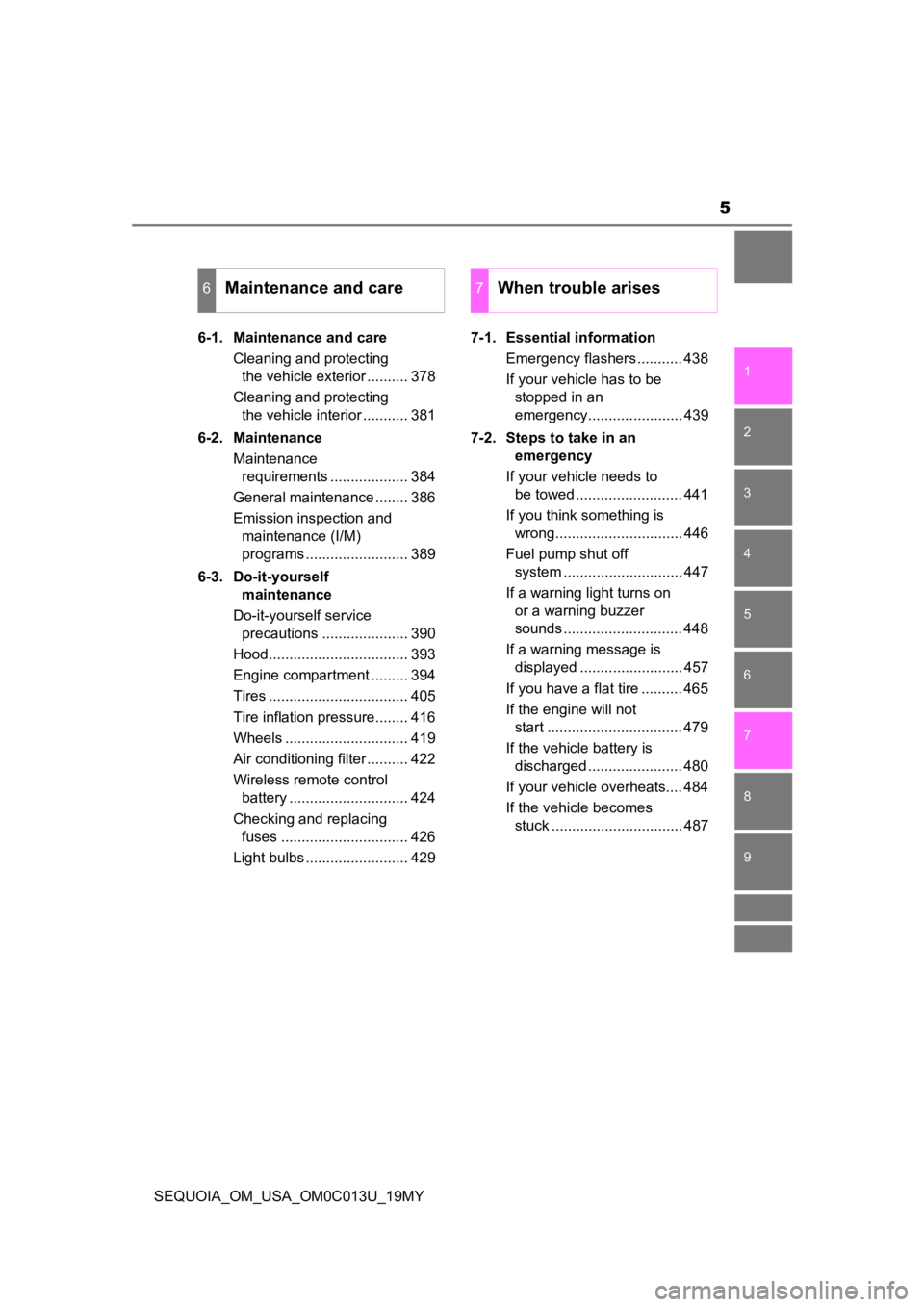
5
1
8 7
6
5
4
3
2
9
SEQUOIA_OM_USA_OM0C013U_19MY6-1. Maintenance and care
Cleaning and protecting the vehicle exterior .......... 378
Cleaning and protecting the vehicle interior ........... 381
6-2. Maintenance Maintenance requirements ................... 384
General maintenance ........ 386
Emission inspection and maintenance (I/M)
programs ......................... 389
6-3. Do-it-yourself maintenance
Do-it-yourself service precautions ..................... 390
Hood.................................. 393
Engine compartment ......... 394
Tires .................................. 405
Tire inflation pressure........ 416
Wheels .............................. 419
Air conditioning filter .......... 422
Wireless remote control battery ............................. 424
Checking and replacing fuses ............................... 426
Light bulbs ......................... 429 7-1. Essential information
Emergency flashers ........... 438
If your vehicle has to be stopped in an
emergency....................... 439
7-2. Steps to take in an emergency
If your vehicle needs to be towed .......................... 441
If you think something is wrong............................... 446
Fuel pump shut off system ............................. 447
If a warning light turns on or a warning buzzer
sounds ............................. 448
If a warning message is displayed ......................... 457
If you have a flat tire .......... 465
If the engine will not start ................................. 479
If the vehicle battery is discharged ....................... 480
If your vehicle overheats.... 484
If the vehicle becomes stuck ................................ 487
6Maintenance and care7When trouble arises
Page 15 of 560
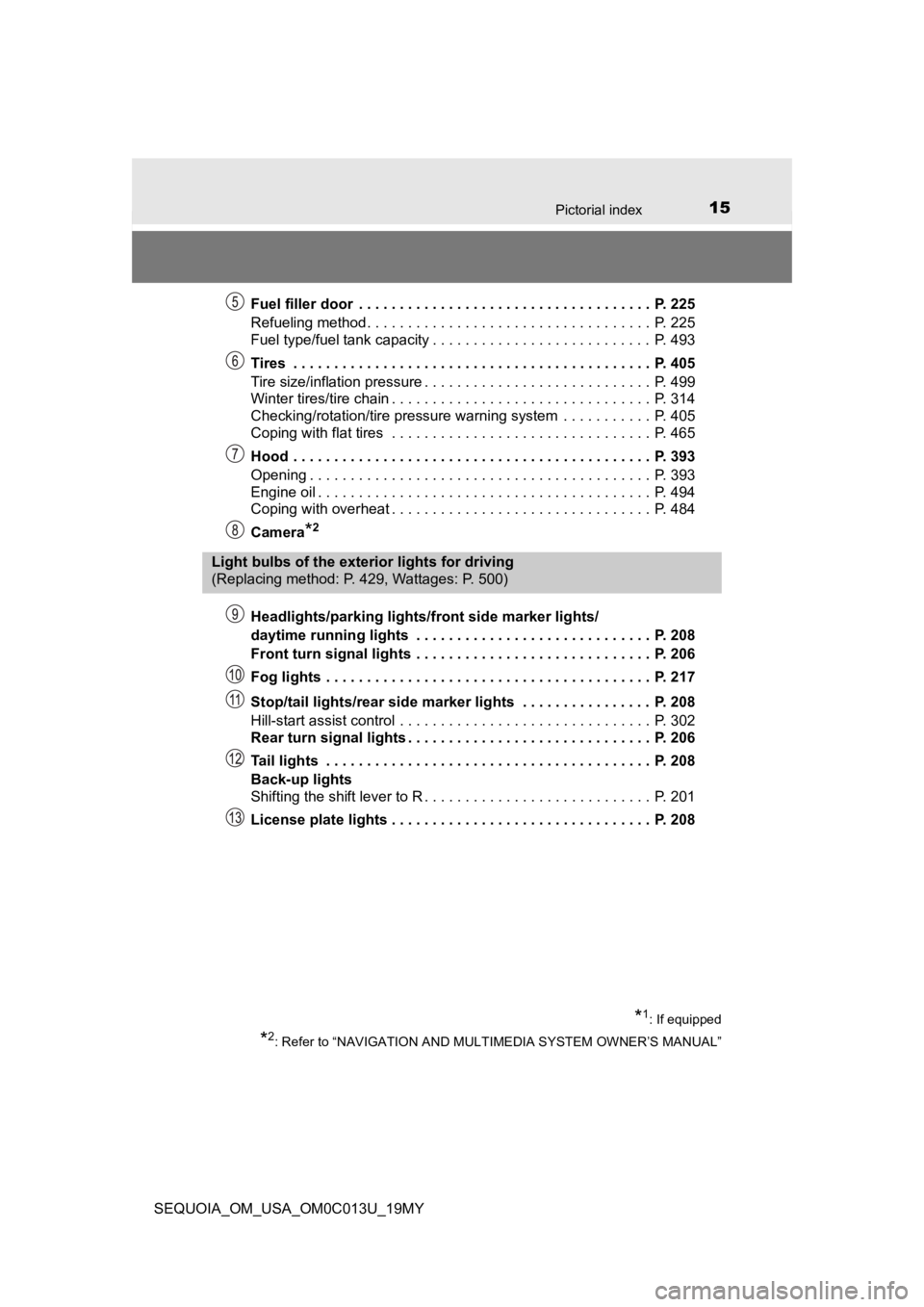
15Pictorial index
SEQUOIA_OM_USA_OM0C013U_19MYFuel filler door . . . . . . . . . . . . . . . . . . . . . . . . . . . . . . . . . . . . P. 225
Refueling method . . . . . . . . . . . . . . . . . . . . . . . . . . . . . . . . . . . P. 225
Fuel type/fuel tank capacity . . . . . . . . . . . . . . . . . . . . . . . . . . . P. 493
Tires . . . . . . . . . . . . . . . . . . . . . . . . . . . . . . . . . . . . . . . . . . . . P. 405
Tire size/inflation pressure . . . . . . . . . . . . . . . . . .
. . . . . . . . . . P. 499
Winter tires/tire chain . . . . . . . . . . . . . . . . . . . . . . . . . . . . . . . . P. 314
Checking/rotation/tire pressure warning system . . . . . . . . . . . P. 405
Coping with flat tires . . . . . . . . . . . . . . . . . . . . . . . . . . . . . . . . P. 465
Hood . . . . . . . . . . . . . . . . . . . . . . . . . . . . . . . . . . . . . . . . . . . . P. 393
Opening . . . . . . . . . . . . . . . . . . . . . . . . . . . . . . . . . . . . . . . . . . P. 393
Engine oil . . . . . . . . . . . . . . . . . . . . . . . . . . . . . . . . . . . . . . . . . P. 494
Coping with overheat . . . . . . . . . . . . . . . . . . . . . . . . . . . . . . . . P. 484
Camera
*2
Headlights/parking lights/front side marker lights/
daytime running lights . . . . . . . . . . . . . . . . . . . . . . . . . . . . . P. 208
Front turn signal lights . . . . . . . . . . . . . . . . . . . . . . . . . . . . . P. 206
Fog lights . . . . . . . . . . . . . . . . . . . . . . . . . . . . . . . . . . . . . . . . P. 217
Stop/tail lights/rear side marker lights . . . . . . . . . . . . . . . . P. 208
Hill-start assist control . . . . . . . . . . . . . . . . . . . . . . . . . . . . . . . P. 302
Rear turn signal lights . . . . . . . . . . . . . . . . . . . . . . . . . . . . . . P. 206
Tail lights . . . . . . . . . . . . . . . . . . . . . . . . . . . . . . . . . . . . . . . . P. 208
Back-up lights
Shifting the shift lever to R . . . . . . . . . . . . . . . . . . . . . . . . . . . . P. 201
License plate lights . . . . . . . . . . . . . . . . . . . . . . . . . . . . . . . . P. 208
Light bulbs of the exterior lights for driving
(Replacing method: P. 429, Wattages: P. 500)
*1: If equipped
*2: Refer to “NAVIGATION AND MULTIMEDIA SYSTEM OWNER’S MANUAL”
Page 82 of 560

822. Instrument cluster
SEQUOIA_OM_USA_OM0C013U_19MY
*1: These lights turn on when the engine switch is turned to the “ON” position
to indicate that a system check is being performed. They will turn off after
the engine is started, or after a few seconds. There may be a m alfunction
in a system if the lights do not come on, or do not turn off. H ave the vehicle
inspected by your Toyota dealer.
*2: The light flashes to indicate a malfunction.
*3: The light illuminates on the multi-information display.
*4: The light comes on to indicate a malfunction.
Low fuel level warning
light ( P. 450)*1
Tire pressure warning
light (P. 451)
*1
Seat belt reminder light
(P. 451)*1
Master warning light
(P. 451)
Page 86 of 560

862. Instrument cluster
SEQUOIA_OM_USA_OM0C013U_19MY
Gauges and meters
Tachometer
Displays the engine speed in revolutions per minute
Engine oil pressure gauge
Displays the engine oil pressure
Outside temperature display
Displays the outside temperature within the range of -40 °F (-40 °C) to
122 °F (50 °C). Low outside temperature indicator comes on when the
ambient temperature is 37 ° F (3 °C) or lower.
Multi-information display
Presents the driver with a variety of vehicle data ( P. 90)
Displays warning messages in case of a malfunction ( P. 457)
Vo l t m e t e r
Displays the charge state
Speedometer
Displays the vehicle speed
Odometer/Trip meter switching and trip meter resetting button
P. 8 7
Fuel gauge
Displays the quantity of fuel remaining in the tank
The displayed content may differ depending on the type of
meter.
Page 94 of 560

942. Instrument cluster
SEQUOIA_OM_USA_OM0C013U_19MY
■Setting items
●“Vehicle Settings” and “Meter Settings” setting items are not s electable
during driving and cannot be operated.
Also, the settings screen is temporarily canceled in the follow ing situations.
• A warning message is displayed.
• The vehicle starts off.
● Settings for functions not equipped to the vehicle are not disp layed.
● When a function is turned off, the related settings for that fu nction are not
selectable.
■ Pop-up display
In some situations, such as when a switch operation is performe d, a pop-up
display will be temporarily displayed on the multi-information display.
■ When disconnecting and reco nnecting battery terminals
The drive information will be reset.
■ Trip Summary display
When the engine switch is turned off, each of the following wil l be displayed
on the multi-information display, and will extinguish after approximately
30 seconds.
● Distance traveled
● Average fuel economy
● Driving range
■ Tire inflation pressure
●It may take a few minutes to display the tire inflation pressur e after the
engine switch is turned to the “ON” position. It may also take a few minutes
to display the tire inflation pressure after inflation pressure has been
adjusted.
● “---” may be displayed if the tire position information cannot be determined
due to unfavorable radio wave conditions.
● Tire inflation pressure changes with temperature. The displayed values may
also be different from the values measured using a tire pressur e gauge.
■ Liquid crystal display
Small spots or light spots may appear on the display. This phen omenon is
characteristic of liquid crystal displays, and there is no prob lem continuing to
use the display.
Page 325 of 560
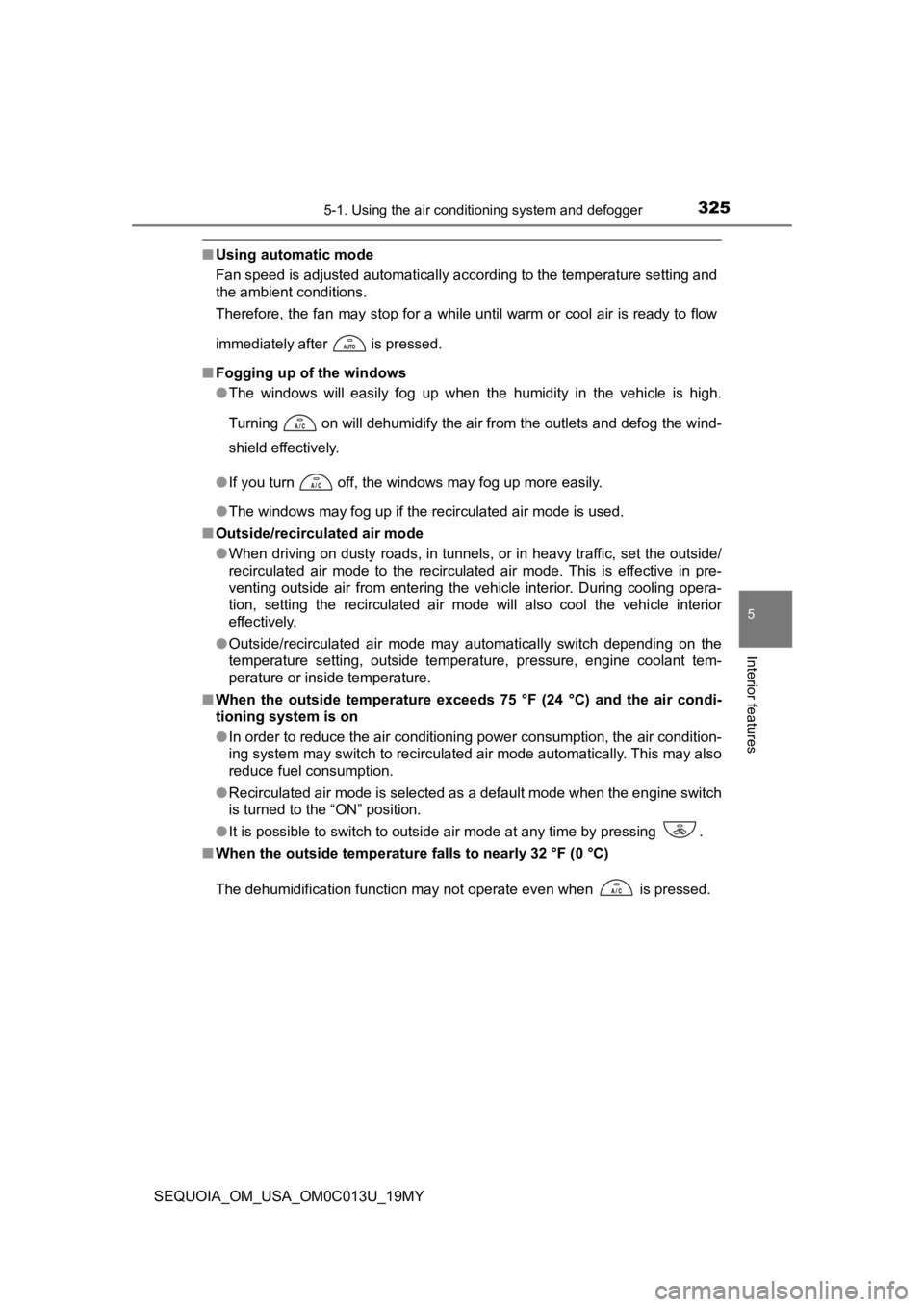
3255-1. Using the air conditioning system and defogger
5
Interior features
SEQUOIA_OM_USA_OM0C013U_19MY
■Using automatic mode
Fan speed is adjusted automatically according to the temperatur e setting and
the ambient conditions.
Therefore, the fan may stop for a while until warm or cool air is ready to flow
immediately after is pressed.
■ Fogging up of the windows
●The windows will easily fog up when the humidity in the vehicle is high.
Turning on will dehumidify the air from the outlets and defog the wind-
shield effectively.
● If you turn off, the windows may fog up more easily.
● The windows may fog up if the recirculated air mode is used.
■ Outside/recirculated air mode
●When driving on dusty roads, in tunnels, or in heavy traffic, s et the outside/
recirculated air mode to the recirculated air mode. This is eff ective in pre-
venting outside air from entering the vehicle interior. During cooling opera-
tion, setting the recirculated air mode will also cool the vehi cle interior
effectively.
● Outside/recirculated air mode may automatically switch dependin g on the
temperature setting, outside temperature, pressure, engine cool ant tem-
perature or inside temperature.
■ When the outside temperature exceeds 75 °F (24 °C) and the air condi-
tioning system is on
● In order to reduce the air conditioning power consumption, the air condition-
ing system may switch to recirculated air mode automatically. This may also
reduce fuel consumption.
● Recirculated air mode is selected as a default mode when the en gine switch
is turned to the “ON” position.
● It is possible to switch to outside air mode at any time by pre ssing
.
■When the outside temperature f alls to nearly 32 °F (0 °C)
The dehumidification function may not operate even when is pre ssed.
Page 379 of 560
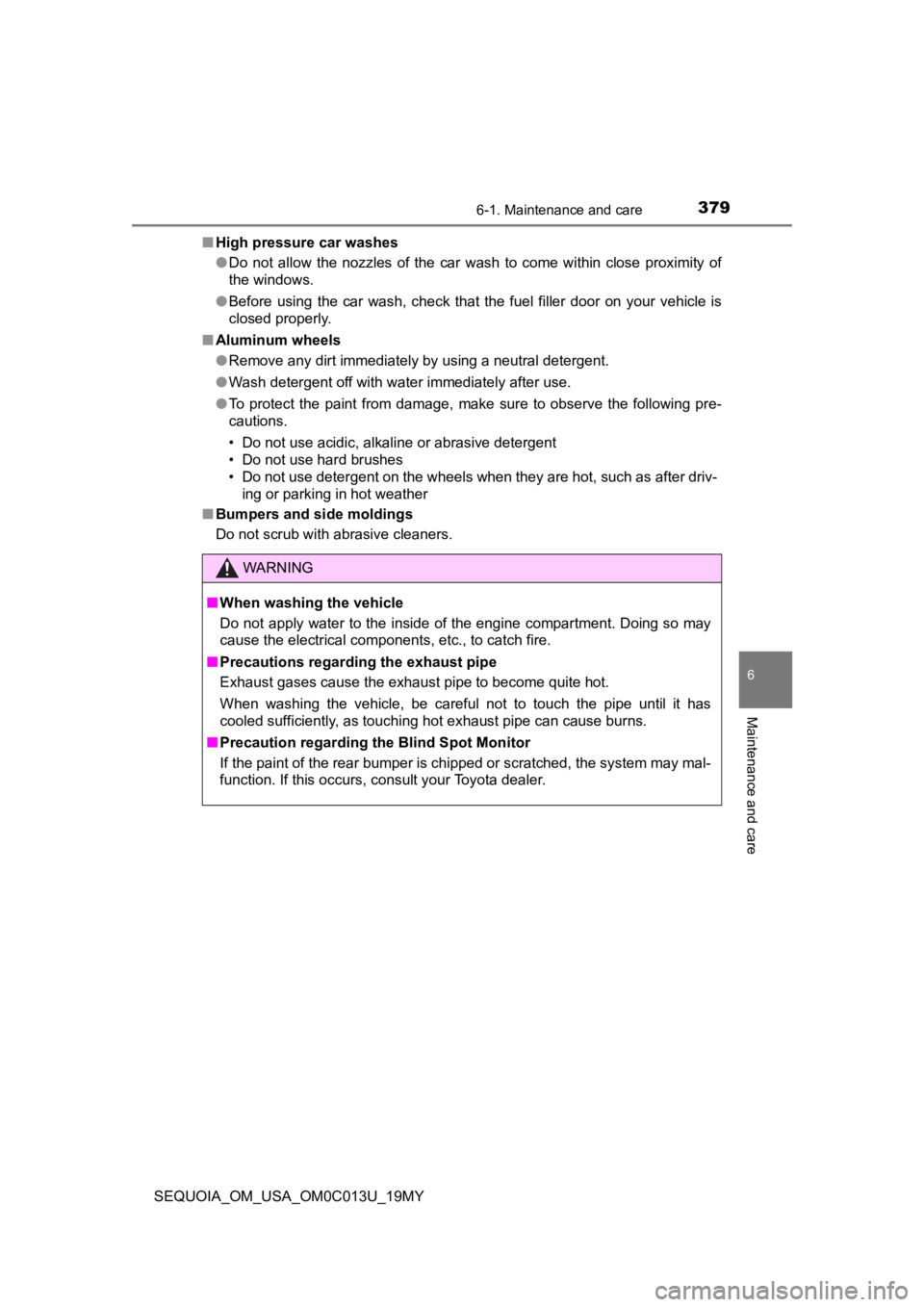
3796-1. Maintenance and care
6
Maintenance and care
SEQUOIA_OM_USA_OM0C013U_19MY■
High pressure car washes
●Do not allow the nozzles of the car wash to come within close p roximity of
the windows.
● Before using the car wash, check that the fuel filler door on your vehicle is
closed properly.
■ Aluminum wheels
●Remove any dirt immediately by using a neutral detergent.
● Wash detergent off with water immediately after use.
● To protect the paint from damage, make sure to observe the following pre-
cautions.
• Do not use acidic, alkaline or abrasive detergent
• Do not use hard brushes
• Do not use detergent on the wheels when they are hot, such as after driv-
ing or parking in hot weather
■ Bumpers and side moldings
Do not scrub with abrasive cleaners.
WARNING
■When washing the vehicle
Do not apply water to the inside of the engine compartment. Doing so may
cause the electrical components, etc., to catch fire.
■ Precautions regarding the exhaust pipe
Exhaust gases cause the exhaust pipe to become quite hot.
When washing the vehicle, be careful not to touch the pipe unti l it has
cooled sufficiently, as touching hot exhaust pipe can cause burns.
■ Precaution regarding the Blind Spot Monitor
If the paint of the rear bumper is chipped or scratched, the system may mal-
function. If this occurs, consult your Toyota dealer.
Page 417 of 560

4176-3. Do-it-yourself maintenance
6
Maintenance and care
SEQUOIA_OM_USA_OM0C013U_19MY
Tire valve
Tire pressure gauge
Remove the tire valve cap.
Press the tip of the tire pressure gauge onto the tire valve.
Read the pressure using the gauge gradations.
If the tire inflation pressure is not at the recommended level, adjust
the pressure.
If you add too much air, press the center of the valve to defla te.
After completing the tire inflation pressure measurement and
adjustment, apply soapy water to the valve and check for leakage.
Put the tire valve cap back on.
■Tire inflation pressure check interval
You should check tire inflation p ressure every two weeks, or at least once
a month.
Do not forget to check the spare.
■Effects of incorrect tire inflation pressure
Driving with incorrec t tire inflation pressure may result in th e following:
●Reduced fuel economy
●Reduced driving comfort and poor handling
●Reduced tire life due to wear
●Reduced safety
●Damage to the drive train
If a tire needs frequent inflating , have it checked by your Toyota dealer.
Inspection and adjustment procedure
1
2
3
4
5
6
Page 455 of 560

4557-2. Steps to take in an emergency
7
When trouble arises
SEQUOIA_OM_USA_OM0C013U_19MY
WARNING
■Maintenance of the tires
Each tire, including the spare (if provided), should be checked monthly
when cold and inflated to the inflation pressure recommended by the
vehicle manufacturer on the vehicle placard or tire inflation p ressure
label (tire and load information label). (If your vehicle has t ires of a dif-
ferent size than the size indicated on the vehicle placard or t ire inflation
pressure label [tire and load information label], you should de termine
the proper tire inflation p ressure for those tires.)
As an added safety feature, your vehicle has been equipped with a tire
pressure monitoring system (TPMS -tire pressure warning system) that
illuminates a low tire pressure telltale (tire pressure warning light) when
one or more of your tires is significantly under-inflated. Acco rdingly,
when the low tire pressure telltale (tire pressure warning ligh t) illumi-
nates, you should stop and check your tires as soon as possible , and
inflate them to the proper pressure. Driving on a significantly under-
inflated tire causes the tire to overheat and can lead to tire failure.
Under-inflation also reduces fuel efficiency and tire tread lif e, and may
affect the vehicle’s handling and stopping ability.
Please note that the TPMS (tire pressure warning system) is not a sub-
stitute for proper tire maintenance, and it is the driver’s res ponsibility to
maintain correct tire pressure, even if under-inflation has not reached
the level to trigger illumination of the TPMS low tire pressure telltale (tire pressure warning light).
Your vehicle has also been equipped with a TPMS (tire pressure warn-
ing system) malfunction indicato r to indicate when the system is not
operating properly. The TPMS (tire pressure warning system) mal func-
tion indicator is combined with the low tire pressure telltale (tire pressure
warning light). When the system detects a malfunction, the tell tale will
flash for approximately one minute and then remain continuously illumi-
nated. This sequence will continue upon subsequent vehicle star t-ups
as long as the malfunction exists . When the malfunction indicator is illu-
minated, the system may not be able to detect or signal low tir e pres-
sure as intended.
TPMS (tire pressure warning system) malfunctions may occur for a vari-
ety of reasons, including the installation of replacement or alternate tires
or wheels on the vehicle that prevent the TPMS (tire pressure w arning
system) from functioning properly. Always check the TPMS (tire pres-
sure warning system) malfunction telltale after replacing one or more
tires or wheels on your vehicle to ensure that the replacement or alter-
nate tires and wheels allow the TPMS (tire pressure warning system) to
continue to function properly.
Page 461 of 560
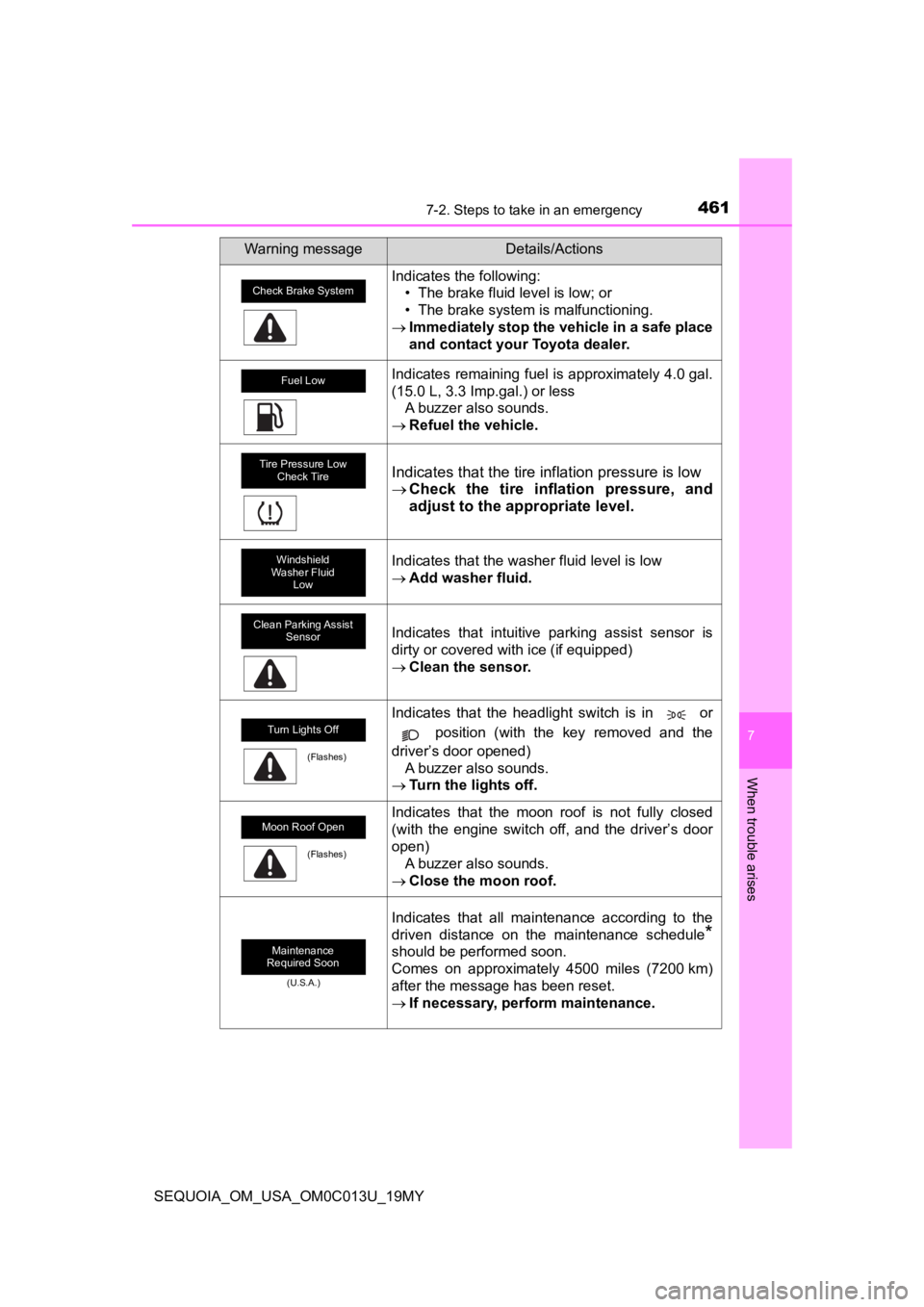
4617-2. Steps to take in an emergency
7
When trouble arises
SEQUOIA_OM_USA_OM0C013U_19MY
Indicates the following:• The brake fluid level is low; or
• The brake system is malfunctioning.
Immediately stop the vehicle in a safe place
and contact your Toyota dealer.
Indicates remaining fuel is approximately 4.0 gal.
(15.0 L, 3.3 Imp.gal.) or less
A buzzer also sounds.
Refuel the vehicle.
Indicates that the tire inflation pressure is low
Check the tire inflation pressure, and
adjust to the appropriate level.
Indicates that the washer fluid level is low
Add washer fluid.
Indicates that intuitive parking assist sensor is
dirty or covered with ice (if equipped)
Clean the sensor.
Indicates that the headlight switch is in or
position (with the key removed and the
driver’s door opened) A buzzer also sounds.
Turn the lights off.
Indicates that the moon roof is not fully closed
(with the engine switch off, and the driver’s door
open)
A buzzer also sounds.
Close the moon roof.
(U.S.A.)
Indicates that all maintenance according to the
driven distance on the maintenance schedule
*
should be performed soon.
Comes on approximately 4500 miles (7200 km)
after the message has been reset.
If necessary, perfo rm maintenance.
Warning messageDetails/Actions
Check Brake System
Fuel Low
Tire Pressure Low
Check Tire
Windshield
Washer Fluid Low
Clean Parking Assist Sensor
Turn Lights Off
(Flashes)
Moon Roof Open
(Flashes)
Maintenance
Required Soon